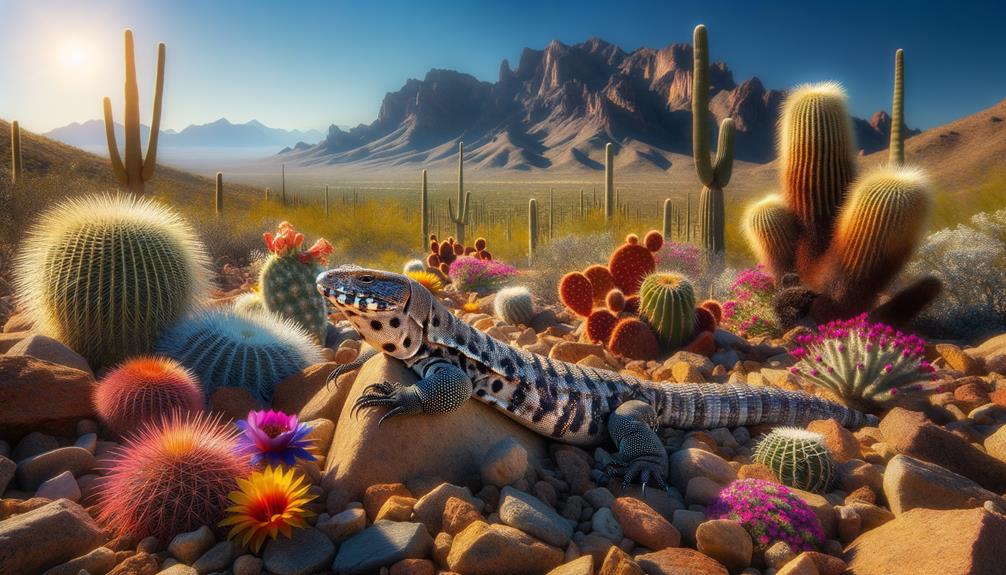The Australian Outback, a seemingly harsh landscape, actually buzzes with life. Take the Thorny Devil, for example. These spiked lizards have mastered survival in one of the world's toughest environments. Their ability to collect water and their specialized diet of tiny black ants showcase their unique adaptations.
What really grabs attention, though, is how these creatures reproduce and maintain their place in the ecosystem. As climate change and human activity reshape their habitat, it's worth asking: What hurdles do Thorny Devils face? How can we ensure they continue to thrive in Australia's arid regions?
These questions aren't just academic. They touch on broader issues of conservation and biodiversity in a rapidly changing world. By understanding the Thorny Devil's role in its environment, we gain insights into the delicate balance of desert ecosystems and the potential ripple effects of their disruption.
Habitat and Distribution
Thorny Devils make their home in Australia's driest regions, particularly where sandy deserts, spinifex grasslands, and scrubland offer ideal conditions. These tough lizards thrive in the Outback's harsh environment, which provides them with cover and food. You'll find them across large swaths of Western Australia, the southern part of the Northern Territory, South Australia, and western Queensland. Nailing down their exact range is tricky, given the vast, empty, and often unreachable areas they inhabit.
While we're not sure about their exact numbers, Thorny Devils are currently listed as Least Concern by the IUCN. This suggests their population is holding steady and not facing immediate threats. Still, given the complexities of their habitat, keeping an eye on these critters is crucial for their long-term survival.
These unique reptiles aren't just a biological curiosity; they hold special meaning for Aboriginal groups. Thorny Devils play a key role in the Outback's ecosystem, adding to its rich tapestry of life. Their ability to flourish in such a tough environment showcases nature's incredible adaptability.
Physical Characteristics
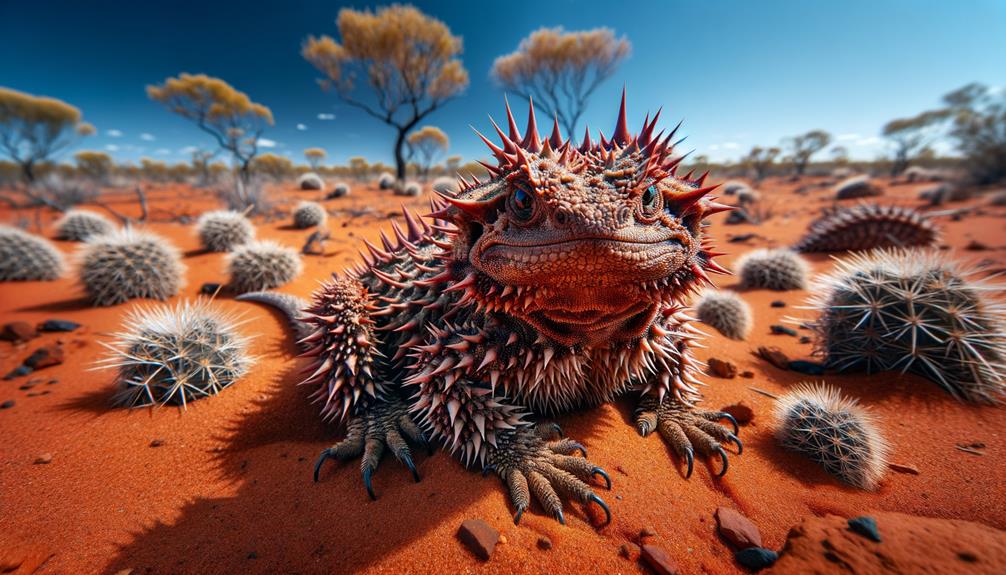
The Thorny Devil's impressive defense mechanisms are clear from its sharp, hard spines. These spikes, covering a body typically 20 cm long, not only ward off predators but also give the creature a fierce look. This armor is a key part of the lizard's physical makeup, providing solid protection.
These lizards can also shift their color based on temperature and mood, helping them blend in. This isn't just for show – it's a vital survival tool in Australia's harsh Outback. By matching their surroundings, they avoid being spotted by predators as they slowly move across the land.
A clever trick up the Thorny Devil's sleeve is its fake head, located on its neck. This decoy confuses attackers, making them unsure which end to target. Adding to their survival toolkit, these lizards can channel water from their skin straight to their mouth, staying hydrated in dry conditions. Each physical feature of the Thorny Devil points to its remarkable evolution, tailored for life in a challenging environment.
Feeding Habits
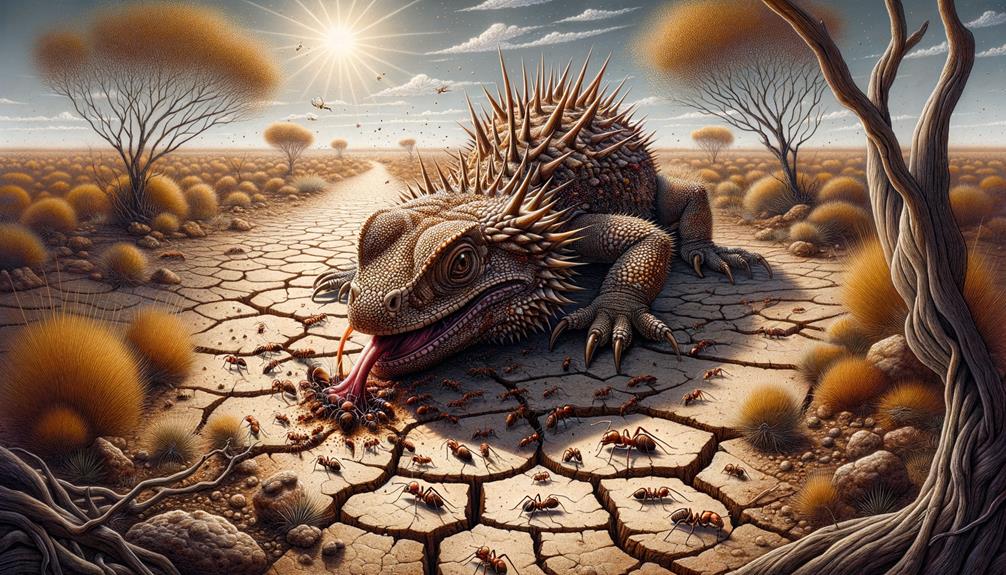
In Australia's remote Outback, these striking lizards have a rather specific taste: they munch almost exclusively on tiny black ants. This unique diet showcases their specialized hunting skills. Thorny Devils are ace ant hunters, gobbling up over a thousand ants in one sitting – a testament to their hearty appetite and adaptability.
These lizards have some intriguing eating habits. They typically hunt when it's cooler out, coinciding with peak ant activity. This timing ensures they find plenty of food while dodging the intense Outback heat. Their sticky tongue is a key tool, snagging ants with impressive speed and accuracy as they march across the sandy landscape.
Ants provide the Thorny Devil with crucial nutrients for survival. But their diet isn't just about food – it defines their ecological role as ant specialists. This focused feeding approach allows them to thrive in one of the world's toughest environments, making their story one of remarkable adaptation and specialization.
Defensive Mechanisms
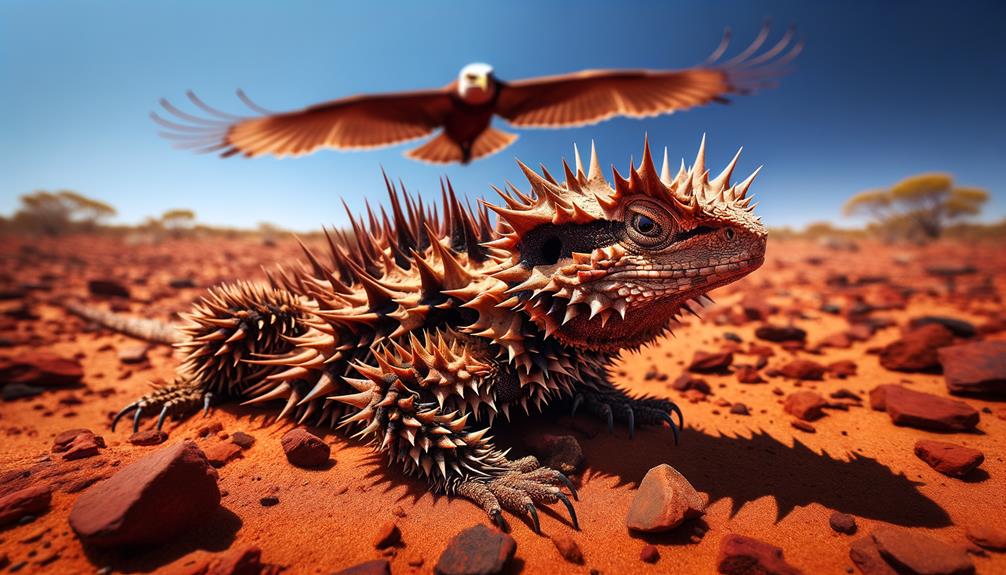
The thorny devil's survival tactics in Australia's harsh Outback are remarkable. These lizards have developed an array of defenses that allow them to thrive in challenging conditions. Their spiky exterior acts as a deterrent to potential predators, while their expert camouflage helps them blend seamlessly into their surroundings. Adding to their arsenal is a unique water collection method, crucial for survival in arid environments. These adaptations work in harmony, providing the thorny devil with a robust set of tools to navigate the unforgiving Australian wilderness.
Let's take a closer look at how these fascinating features combine to shield the thorny devil from the numerous threats in its environment. Understanding these mechanisms offers insight into the intricate ways nature equips creatures to face extreme challenges.
Camouflage and Coloration
Thorny devils possess a remarkable talent for changing their skin color, helping them disappear into the sandy landscape of the Australian Outback. This chameleon-like ability, influenced by temperature and mood, lets them vanish among the varied shades of their desert home, making them tough to spot for potential predators.
Their unique appearance combines camouflage with a spiky exterior, creating a powerful defense mechanism. While the thorny devil's spines might seem aggressive, they actually help it blend in. The intricate patterns on its skin mimic the textures and colors of its surroundings, making it even harder to detect. It's a perfect example of nature's design, tailored for survival in one of the world's toughest environments.
Across the wide-open spaces of the Australian Outback, where every grain of sand tells a story of freedom, the thorny devil stands out as a testament to nature's creativity. Its camouflage and coloration aren't just survival tactics; they're the result of a fascinating evolutionary journey, perfectly adapted to its unique ecosystem.
Spiky Armor Defense
The thorny devil, a native of Australia's harsh Outback, boasts an impressive set of defenses that help it survive in its unforgiving habitat. Its most striking feature is its coat of sharp spines, which act as a powerful deterrent against hungry predators like birds and goannas. These spikes not only make the lizard hard to swallow but also cause discomfort to any animal that tries.
One of the thorny devil's clever tricks is its fake head, positioned on the back of its neck. When danger looms, the lizard ducks its real head and presents this decoy, buying precious seconds to make a getaway. The thorny devil can also puff up its body, making itself look even more intimidating to would-be attackers.
These survival strategies are crucial in the Outback's tough environment. The thorny devil's spiky armor and decoy head showcase nature's ingenuity, fine-tuned over countless generations. In the daily fight for survival, these adaptations give the thorny devil a fighting chance, allowing it to thrive despite the many challenges of its arid home.
Unusual Water Collection
The thorny devil's spiky exterior isn't its only remarkable feature. This Australian Outback dweller has a clever way of getting water that's crucial for surviving in the harsh desert. Its skin has tiny grooves that use physics to pull moisture towards its mouth. This trick lets the lizard sip water from rain, morning dew, and even damp sand.
When water hits the thorny devil's skin, these mini-channels guide every drop to where it's needed most. It's a smart solution for life in a place where water is hard to come by. This ability to make the most of scarce resources shows how animals adapt to tough environments.
The thorny devil's water-collecting method is a prime example of nature's problem-solving skills. In the unforgiving Outback, such adaptations aren't just neat tricks – they're essential for survival. This lizard's success in such a challenging habitat highlights the importance of its unique features.
This fascinating process gives us a glimpse into the incredible ways animals evolve to thrive in even the most difficult conditions. It's a testament to the resilience and ingenuity found in nature, especially in places where life seems nearly impossible.
Reproductive Behavior
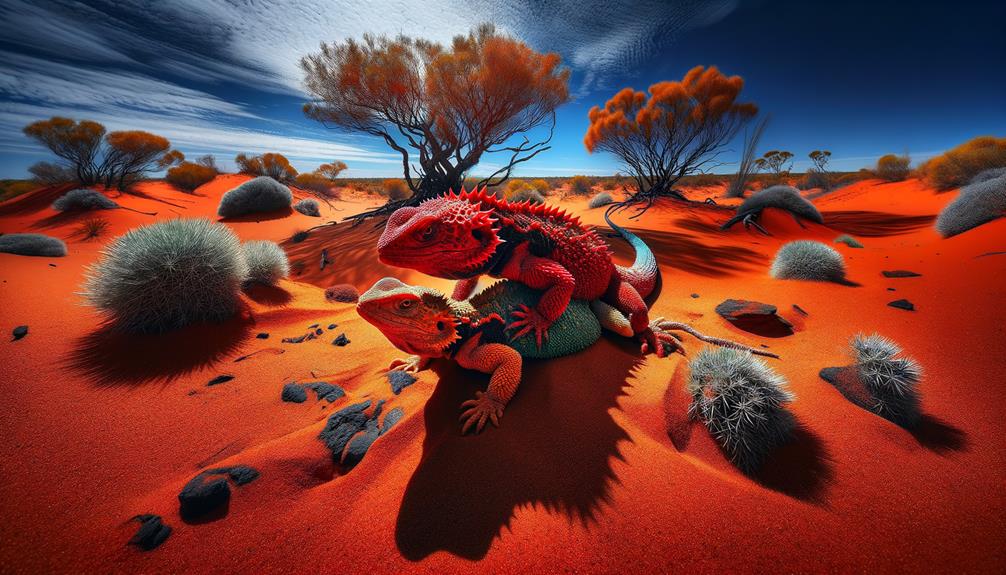
Thorny Devils showcase intriguing mating habits. These unique reptiles typically pair up between August and December. Female Thorny Devils take extra precautions, digging deep burrows to safely deposit their eggs. Once the young hatch, they immediately display their self-sufficiency. In a remarkable display of resourcefulness, the hatchlings consume their own egg cases, extracting vital nutrients. This behavior exemplifies their adaptation to the challenging desert conditions they call home.
Mating Season Patterns
From August to December, male Thorny Devils in the Australian Outback put on quite a show. They bob their heads and wave their legs in intricate patterns to catch the eye of potential mates. These displays are crucial for their breeding success in the vast, sandy landscape.
The mating ritual is a key part of the Thorny Devils' life cycle. Females watch the males' performances closely before picking a partner. After mating, females dig deep burrows in the tough ground and lay between 3 and 10 eggs. These burrows offer protection for the eggs as they develop.
This whole process, from the males' flashy displays to the females laying eggs, shows how well Thorny Devils have adapted to their harsh environment. Their ability to breed successfully in such tough conditions is a testament to their resilience and helps ensure the species' survival in the Outback.
Egg Laying Habits
Female Thorny Devils show fascinating egg-laying behavior. They dig sandy burrows about 30cm deep between September and December, laying 3 to 10 eggs in each clutch. These carefully chosen spots offer ideal conditions for egg development, crucial in the harsh Australian Outback.
These lizards follow a yearly breeding cycle, with females laying eggs once annually. After depositing her eggs, the mother covers the burrow, hiding it from potential threats. The eggs stay buried for roughly 3 to 4 months as the embryos grow.
| Clutch Size | Burrow Depth | Incubation Period |
|---|---|---|
| 3 to 10 eggs | 30cm | 3 to 4 months |
This approach ensures young Thorny Devils hatch when survival odds are best. The care taken in egg-laying showcases how well these unique creatures have adapted to their environment, highlighting their resilience and resourcefulness.
The Thorny Devil's reproductive habits offer a glimpse into nature's ingenuity. By timing their breeding and choosing suitable nesting sites, these lizards give their offspring the best chance at life in a challenging ecosystem.
Offspring Survival Strategies
Thorny Devils have impressive ways to keep their young alive in the tough Australian Outback. Female devils dig sandy holes and lay between 3 and 10 eggs from September to December. These eggs take about 3 to 4 months to hatch, and when they do, the baby devils are ready to fend for themselves.
As soon as they break out of their shells, these little critters start munching on ants right away. Interestingly, they also eat their own eggshells, which gives them a boost of energy and size. This quick meal is key for their survival in a place where food can be hard to find.
These lizards start having babies when they're about 2 to 3 years old, following a yearly cycle. Their spiky skin isn't just for show – it helps scare off predators and lets them blend in with the rough landscape. It's a key part of how they protect themselves.
Through these clever tricks, Thorny Devils give their babies a real shot at making it in the harsh Outback environment. Their unique features and behaviors show how well they've adapted to life in one of Australia's toughest regions.
Conservation Status

Thorny Devils, despite their formidable appearance, aren't currently at risk of extinction. The International Union for Conservation of Nature lists them as "Least Concern." But this doesn't mean we can ignore their well-being. These odd-looking lizards need our help to keep their homes safe.
As cities and towns grow, the Thorny Devils' natural habitat shrinks. We need to make sure there's enough untouched land for them to live on. It's not just about saving space, though. The changing climate poses a big problem too. As temperatures shift and weather patterns change, these creatures might struggle to adapt.
There's another threat to watch out for: people who want to keep Thorny Devils as pets. Taking these animals from the wild is illegal and harmful. It messes with their natural behaviors and can hurt the ecosystems they're part of. Tough laws and penalties are needed to stop this practice.
Getting people to care about Thorny Devils is key. When folks understand why these lizards matter, they're more likely to support efforts to protect them. Using social media, news outlets, and community events can help spread the word. The goal is to make sure these unique animals stick around for future generations to admire.
Frequently Asked Questions
What Australian Animal Has Thorns?
The Thorny Devil stands out among Australian wildlife with its distinctive spiky exterior. These sharp, cone-shaped spines aren't just for show – they're a robust defense system. I'm always amazed by how this creature has adapted to thrive in challenging environments. Its unique features make it a true survivor in Australia's harsh outback. The Thorny Devil's ability to blend in and protect itself is a testament to nature's ingenuity. It's fascinating to see how evolution has equipped this small lizard to face its desert habitat's many threats.



